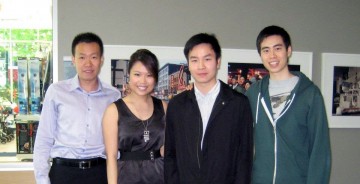Melissa Carr (Communications Coordinator, UBC Faculty of Medicine)
I recently attended the Undergraduate Medicine Research Forum and was impressed with all of the student projects that were presented, however, one really stood out for me. The students involved decided to take a look at how their medical education is preparing them to deal with a cross-cultural issue common to the Vancouver/Fraser region: communication with diversely ethnic populations. Medical students are learning how to physically treat patients, but are they becoming adequately prepared to communicate with them. I posed some questions to team member, Jackson Chu, to learn more about their findings.
What interested you about this subject?
The four of us (Jackson Chu, Kristy Cho, Charlie Zhang and Jonathan Yang) decided to undertake this project during the Doctor, Patient and Society (DPAS) course in second year of medical school. The subject matter was interesting to us for a number of reasons. We wanted to gain a deeper appreciation of Chinese language and culture, to learn how to be more aware of the issues that Chinese immigrants face but cannot communicate effectively to the “Western” health care practioner, and to develop strategies that can help students in the health care profession feel more confident identifying and addressing these barriers.
Our project had several objectives, along with the research objective which we presented at the UBCMJ Research Forum. Firstly, we wanted to be integrated into the events offered to the Chinese community in the Lower Mainland. We attended the SUCCESS Health Fair and the Intercultural Online Health Network (iCON) Health Forum, participating in Cantonese/ Mandarin workshops on managing chronic diseases. Second, we organized educational sessions for students from various health care professional schools including Medicine, Nursing, Pharmacy and Physiotherapy, teaching strategies to engage Chinese patients. We also hosted a Chinese language workshop for medical students, teaching basic phrases that can be use in patient encounters. Lastly, with the support of the UBC Knowledge Studio and the eHealth Strategy Office, we interviewed and videotaped a group of physicians experienced in caring for Chinese patients and we produced a series of short films.
We would like to acknowledge Dr. Kendall Ho, our mentor as well as the Director of the eHealth Strategy Office, who has provided us with valuable mentoring and whose support of this project made it possible.
What was your method of research?
Last February, we distributed an online survey (5-10 minutes to complete) via Med-all, the internal emailing list for medical students currently studying at UBC. The survey collected responses on demographics, knowledge and awareness of barriers to Chinese accessing health care identified in the literature, as well as attitudes and willingness to work with Chinese patients. Students were also asked whether they felt that they should be provided with ongoing training to enhance their knowledge and skills in working with various immigrant populations.
Demographics were recorded as an open, typed response. Knowledge and awareness questions were presented as a statement (e.g./ Many older Chinese, especially immigrants, are accustomed to seeing a physician only when they are sick) and answered by selecting True/ False/ Don’t know to the corresponding statement. Questions on attitudes and willingness to work with Chinese patients were presented with a statement (e.g./ I will be as willing to accept non-English speaking patients as English speaking patients) and answered by selecting a number from 1 to 5 (1-Completely disagree; 2-Somewhat disagree; 3-Neither agree nor disagree; 4-Somewhat agree; 5-Completely agree).
What conclusions did you reach?
We found that medical students across all years of training at UBC felt significantly less ready to provide care for non-English speaking Chinese patients than for any other patient. The ability to speak Chinese, self-identified skill in working with interpreters, and higher level of medical school training correlate with student preparedness in working with the non-English speaking Chinese population. More cultural competency training in the medical curriculum is warranted and would be welcomed by the majority of students.
Vancouver and B.C. have large populations of minority groups. How important do you think it will be for future doctors, like yourself, to be able to effectively communicate with these groups? Why?
We believe that effective communication is very important to patient care. From taking a thorough history to discussing the management plan, a physician must utilize and interpret verbal and non-verbal cues in order to understand the problem, treat the disease and counsel the patient. It is especially important for current and future doctors to communicate effectively with the immigrant and minority populations in B.C. as their cultural beliefs and language challenges can often lead to health care barriers. Establishing a therapeutic relationship between the care provider and patients is important for effective communication and requires acceptance and understanding of each individual’s unique cultural, religious and personal beliefs, cultural practises, and expectations for care.
What would be your recommendations for how medical students can become better prepared to care for ethnic minorities?
From the survey results, recommendations to improve the current training process include encouraging multicultural exposure in clinical training, providing ongoing education in cultural competency, and formal teaching on working with interpreters.
Our group has also created several short videos based on interviews from expert physicians sharing their tips for overcoming cultural barriers. These topics include (1) Traditional Chinese medicine, (2) Language barriers and translators, (3) General cultural differences, (4) End of life, (5) Mental health, (6) Differences in health care systems. Later in the year, we hope to have the videos ready for everyone to watch.

Comments are closed, but trackbacks and pingbacks are open.